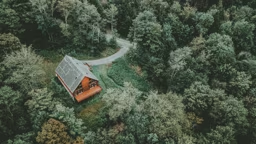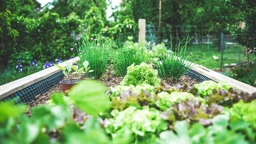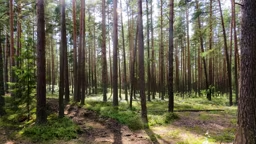In that scenario, one might think the soap running toward the lake is the problem. But before you place all the blame on that stream of slippery soap bubbles, take a closer look at its partner in crime — the paved driveway.
Pavement is an impervious surface that doesn’t allow rain or other water to filter through the ground. Instead, it can send large amounts of warmed and contaminated water cascading into lakes and rivers, poisoning your lake and accelerating erosion. Besides paved or concrete driveways, other impervious surfaces include hard rooftops (versus earthen ones), sidewalks and patios as well as hard, compacted soils.
So, what are the alternatives? The first thing to do is minimize the number and size of impervious surfaces. You obviously can’t easily change the type or size of your roof, and it’s probably not cost-effective to tear out your existing driveway and walkways, but there are some practical steps you can take.
A Softer, Gentler Lawn
If you have some lawn space around your cabin, is the soil hard and compacted? A lot of rainwater may be running right over the top it. You can help soften your lawn so that it can soak up rain like a sponge. Rent a core cultivator from the nearest hardware or rental store. As you push the cultivator around your yard, it’ll remove small plugs of soil and deposit them on the surface. In a few weeks, the plugs will crumble and decompose.
A note on lawns near lakeshores: To impede runoff and erosion, consider establishing a natural, unmowed buffer along the shoreline. Runoff water that isn’t stopped will be filtered by the vegetation so cleaner water will enter the lake.
Rain Gardens & Rain Barrels
One solution to runoff may be to build a rain garden in your open yard space. You’ll direct water away from impervious surfaces to a garden bed filled with deep-rooted, thirsty plants. When designed with stones and native plants, rain gardens create a haven for wildlife and beautify your yard – all while preventing direct runoff into bodies of water. (To read about one cabin family’s rain gardens, see “Bring on the Rain Garden” in the FEB 2008 issue of CABIN LIFE.)
Use rain barrels to capture roof runoff from your gutters, and you can tap that rainwater for watering your other gardens.
Groundcover
Considering a patio area for your place? Gravel and woodchips are good alternatives to impervious surfaces such as concrete, as they allow water to absorb into the ground rather than run to the lake. Gravel can consist of recycled materials such as granite left over from monument factories and provides more traction than paved surfaces.
Woodchips — or other organic matter like shredded bark or nut shells — are also a nice alternative for walkways and sitting areas. Woodchips decompose so you need to add more or replace now and then, but they are cost-effective and allow water to move back into the ground. And for variety, you can choose to change the type and color!
Then there’s rubber. Shredded or chipped recycled rubber, in colors from brick red to earthy brown, is another choice for groundcover.
Incredibly Porous
Beyond groundcover made of gravel, woodchips or rubber, there are other alternatives to traditional impervious surfaces. Porous concrete and asphalt have the stability of traditional concrete and pavement, but allow water to seep through and reduce runoff. Granted, these porous surfaces cost about 2.5 times more than cement and tar, but their longterm impact may outweigh their cost.
Under a porous concrete or asphalt surface, an 18- to 36-inch “recharge bed” of crushed rock is installed (very similar to that found in a septic system) — and it holds the water that comes through the porous surface and allows it to percolate slowly back into the ground. The recharge bed is placed at least 3 feet above the water table.
There is some debate about porous concrete and asphalt surfaces and their true environmental impact. Critics say they require far more rock — and in that respect may not be as beneficial to the environment overall.
There are also new concrete forms that are weight-bearing like a traditional driveway, but have an open grid pattern that grass can grow through — making them pervious!
Pavers Plus
You can always consider using tried and true patio pavers. By installing pavers only in the paths of the tires on driveways or laying stepping pavers on your walkways – and allowing green vegetation to grow up in between — you’re limiting impervious surfaces and discouraging erosion.
Rubber stepping stones are an alternative to traditional pavers. Made from ground-up recycled rubber like the rubber groundcover but shaped into round or rectangle stepping stones, they are durable, provide a softer surface, last up to two times longer than concrete and come in a variety of colors. They’re great for their cushioning effect in areas where children may fall. Rubber stepping stone walkways cost about one-third more than concrete, but their benefits are long lasting.
Installing patio pavers, rain gardens, rain barrels, gravel, woodchips, porous concrete — it’s all about the power of pervious.
Natural Landscaping
Besides moving away from impervious surfaces, there are other steps you can take to control runoff. Even your choice of plants can make a difference.
Native plants are adapted to your soil, climate, sun and moisture conditions, are better able to withstand competition from nonnative invasive plants, often have deep roots and can tolerate heavy rains. For help in choosing plants that are native to your area, ask the master gardener at your local garden center or talk to your county extension officer.
Britta Reque-Dragicevic is pondering the payoff of pavers versus pulverized rubber stepping stones.











